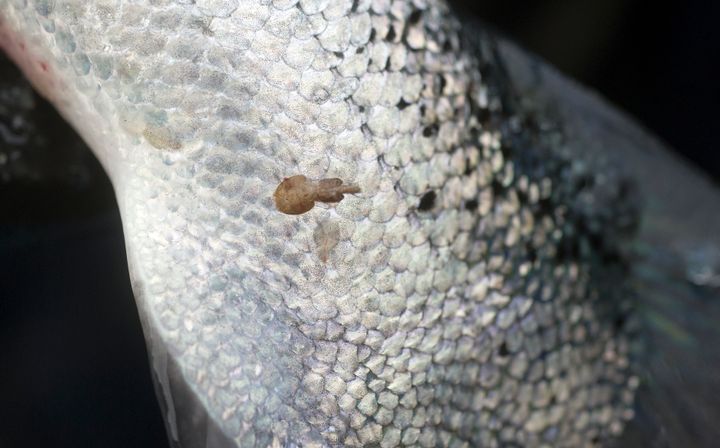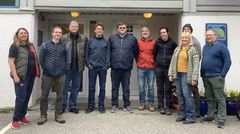Salmon secrete substances that attract sea lice
New research has enhanced our understanding of why sea lice are predominantly attracted to salmon.

The study investigates the chemicals released by Atlantic salmon that serve as attractants to these parasites.
The encounter between a salmon louse and its host begins when the louse is in its free-swimming larval stage, known as a copepodite. But being tiny organisms in a vast ocean, how do they locate salmon as their host?
"Chemical signalling is believed to play a key role in host-parasite communication, and scientists have confirmed this," says Nicholas Robinson from Nofima.
Will enhance resistance to sea lice
Robinson is coordinating the CrispResist project, which brings together a leading team of scientists from Norway, the UK, USA, Canada, Sweden and Australia. Their goal is to uncover the mechanisms behind cross-species variation in host resistance to sea lice and apply this knowledge to enhance Atlantic salmon resistance in aquaculture.
A crucial objective is to identify and document genes and mechanisms responsible for the difference in sea lice resistance between salmonid species. It is well-established that certain Pacific salmon species are resistant to sea lice and can kill them in the early stages of parasitism, whereas Atlantic salmon are highly susceptible.
Senior fish health scientist Aleksei Krasnov at Nofima is involved in studies of chemical communication between lice and salmon. Working with the global team, Krasnov identified putative semiochemicals or compounds of biological origin that affect the behaviour of animals of the same or other species. The type of semiochemicals called kairomones help lice find salmon by scent.
Tested lice behaviour
The discovery involved a wide range of chemical analyses and lice behaviour tests. Water that was conditioned with Atlantic salmon, Pacific salmons and other fish species was analysed. Twenty-one candidate semiochemicals were selected for lice behaviour tests.
Additionally, mucus from Atlantic salmon families with high and low resistance to lice was studied to determine whether resistance could be linked to the chemical composition of the mucus. Behavioural tests were carried out in Norway and a few in Sweden using different methods.
The research showed that water conditioned only with salmon stimulated copepodite activity, confirming the presence of kairomones. Interestingly, conditioned water also contained compounds that deterred lice, suggesting that Atlantic salmon can repel lice as well.
Moreover, the tests suggested that semiochemicals may be produced in various tissues of Atlantic salmon, especially the skin.
Salmon from families susceptible to sea lice were found to produce mucus that had a higher stimulatory effect on lice than salmon from families with high resistance to lice.
Future Research
One of the key outcomes of the study was the identification of compounds for further research. "Overall, the findings suggest that host-parasite communication is highly complex and likely involves multiple cues," says Krasnov.
Krasnov believes that developing molecular tests is the most promising approach for continuing semiochemical research in this field.
The project CrispResist is financed by the Norwegian Seafood Research Fund – FHF. The project is a collaboration between 12 partners from science and industry. In particular, Rothamsted Research (UK), University of Gothenburg (Sweden), Bigelow Laboratory of Ocean Science (USA) and Nofima (Norway) have contributed to this part of the project.
Keywords
Contacts
Reidun Lilleholt Kraugerud
Tel:48197382reidun.lilleholt@nofima.noAleksei KrasnovNofima, avdeling Fiskehelse
Tel:+47 64 97 04 84aleksei.krasnov@nofima.nonofima.no/ansatte/aleksei-krasnov/Nicholas RobinsonNofima - avd. Avl og genetikk
nicholas.robinson@nofima.nonofima.com/employee/nicholas-andrew-robinson/Images

Links
About Nofima
The Norwegian food research institute Nofima provides research based knowledge and innovations for actors in all parts of the food systems.

Subscribe to releases from Nofima
Subscribe to all the latest releases from Nofima by registering your e-mail address below. You can unsubscribe at any time.
Latest releases from Nofima
Scientists create healthy salmon feed from polluting CO₂30.6.2025 10:36:26 CEST | Press release
Polluting CO₂ is turned into nutritious feed for farmed salmon. Science fiction? Absolutely not. All it takes are three innovative research environments, a visionary actor in the heavy metal industry, and large quantities of microalgae.
“Doktor tare” kan bidra til å lage trygge porsjonstørrelser på tareprodukter27.6.2025 07:00:00 CEST | Pressemelding
Hils på «Doktor tare» – Randi Sund. Gjennom arbeidet med sin ferske PhD har hun ervervet kunnskap som kan hjelpe både produsenter, matindustri og forbrukere til å velge trygge størrelser på porsjoner av tare.
Has documented cause of kidney stones in rainbow trout26.6.2025 12:39:57 CEST | Press release
Scientists at Nofima have investigated the impact of carbon dioxide in water on the development of kidney stones in farmed rainbow trout. The research shows a clear connection.
Har dokumentert at CO2 er en årsak til nyrestein hos oppdrettsørret26.6.2025 12:26:14 CEST | Pressemelding
Forskere ved Nofima har sjekket hva karbondioksid i vannet har å si for utvikling av nyrestein hos regnbueørret i oppdrett. Det er en soleklar sammenheng, viser forskningen.
New head of Nofima’s Fish Health Department19.6.2025 14:03:57 CEST | Press release
Kjetil Fyrand has moved from Pharmaq to Nofima and now leads the Fish Health Department.
In our pressroom you can read all our latest releases, find our press contacts, images, documents and other relevant information about us.
Visit our pressroom